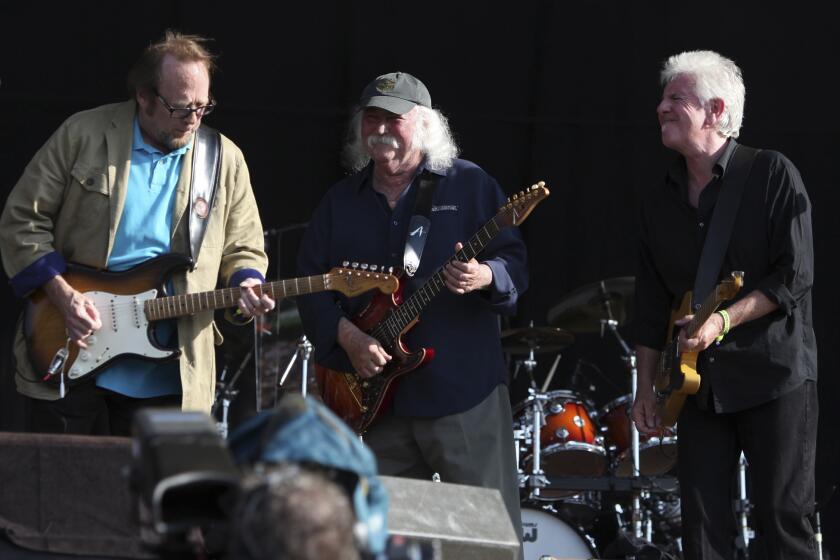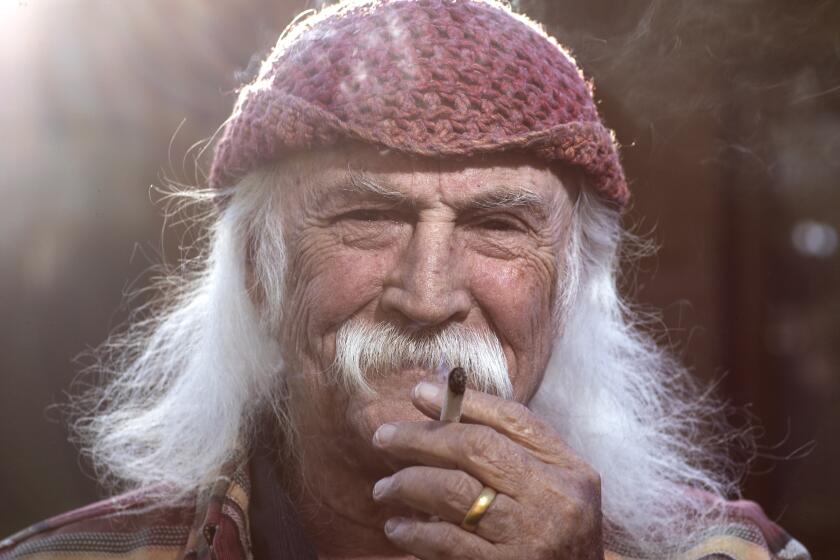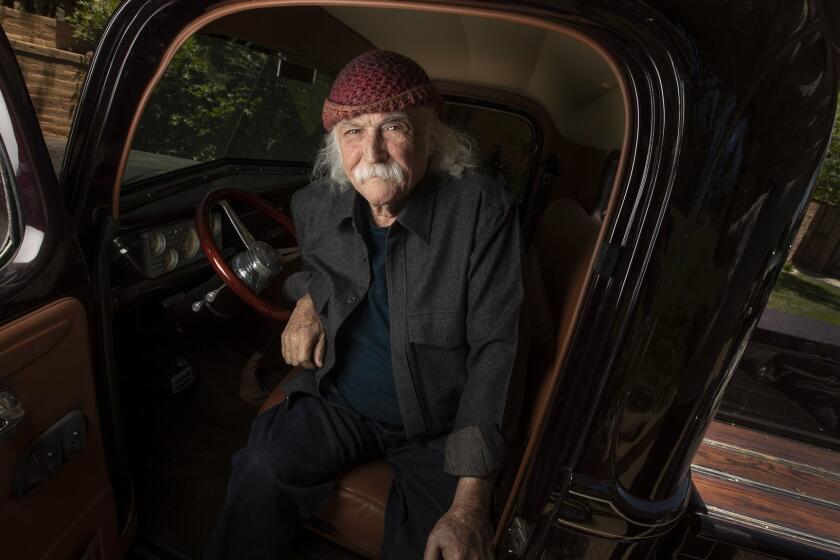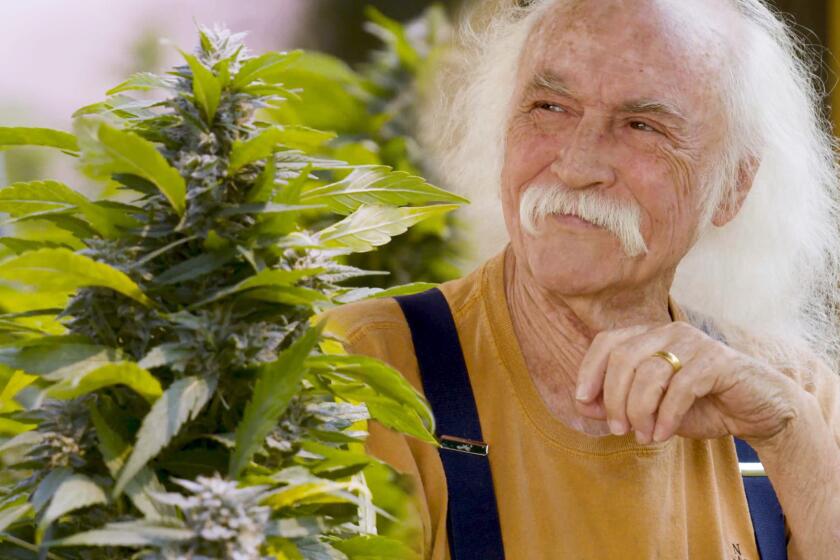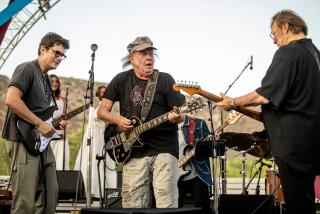David Crosby, whose voice soared with the Byrds and Crosby, Stills, Nash & Young, dies
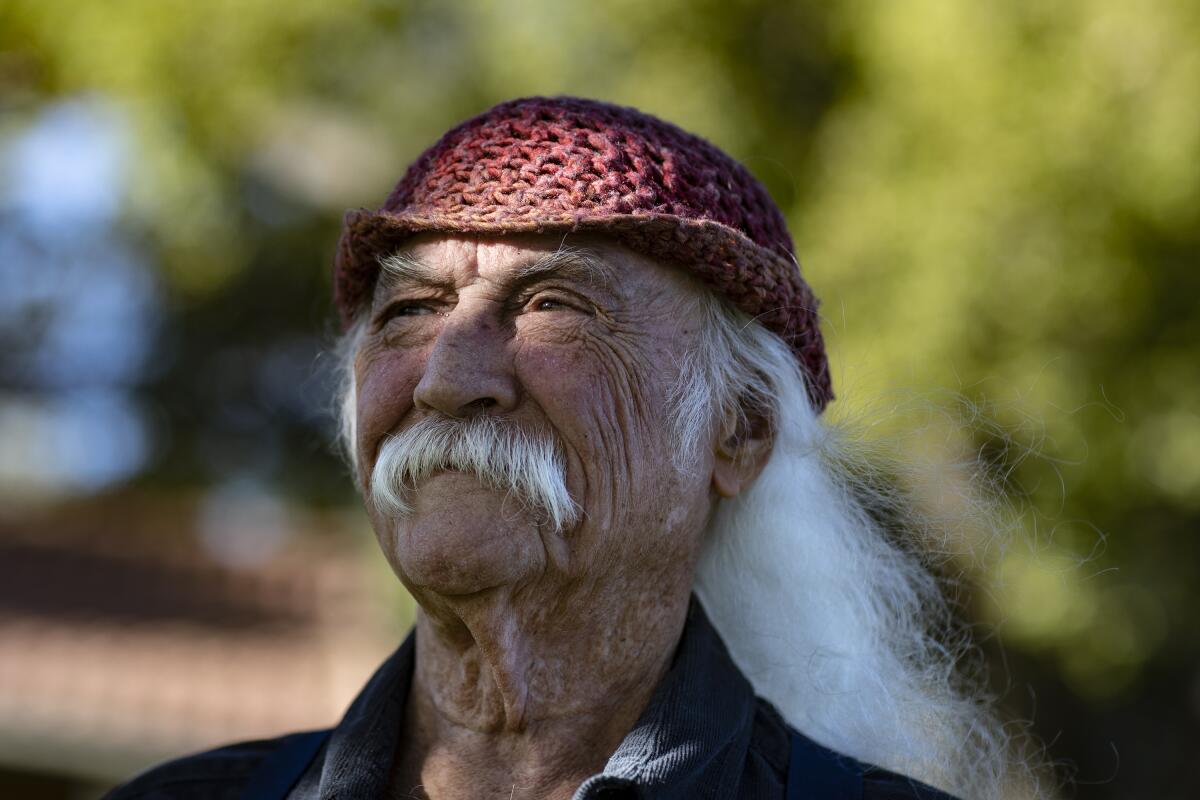
- Share via
Over the years, David Crosby achieved more than many an old hippie musician could even hallucinate. He and his band mates sold 35 million records. He was twice inducted into the Rock & Roll Hall of Fame — once for his years with the groundbreaking folk rock group the Byrds and then for his on-and-off decades with Crosby, Stills & Nash, a group described by the Hall of Fame as “America’s longest-running experiment in vocal harmony and social relevance.”
Crosby sailed the world in a 59-foot Honduran mahogany schooner called the Mayan. He piloted his own plane, lived on a ranch in the wine country north of Santa Barbara, and in his later years experienced a surprising burst of creativity that produced four albums along with concert dates across the country.
The bigger surprise, though, was that he had any later years at all. He suffered from diabetes and arterial disease, was implanted with eight cardiac stents, and survived heart attacks, blackouts, seizures and a motorcycle wreck. When hepatitis C destroyed his liver in 1994, doctors saved his life with a transplant. He was addicted to alcohol, heroin and cocaine, and got clean only after spending 11 months behind bars in Texas for drug and weapon offenses.
Asked in the 2019 documentary “David Crosby: Remember My Name” how he had managed to keep going, he answered succinctly: “No idea, man.”
Graham Nash and Stephen Stills were among those in the music world paying tribute to David Crosby after news of the singer’s death.
The co-founder of two supergroups that broadened and deepened the reach of rock music, and who, with his outspoken political pronouncements and famously outsized appetites came to symbolize the Woodstock generation’s exuberance and excesses, died at 81, it was confirmed Thursday by a source close to the musician. Patricia Dance, a sister of Crosby’s wife, told the New York Times that the musician died Wednesday evening.
Cosby had been bedeviled by drug and alcohol addictions early in life and then corresponding medical problems as he grew old.
A guitarist who sang in a crystal-clear middle tenor, Crosby had a voice sometimes described as angelic. He wrote or co-wrote songs with evocative lyrics and unusual tunings, and many of them — “Eight Miles High,” “Guinnevere,” “Wooden Ships,” “Long Time Gone” — continue stirring the hearts of fans who had long since traded their mescaline for Medicare.
For some, Crosby took his place in rock history on Aug. 18, 1969, when he performed at Woodstock with Stephen Stills, Graham Nash and the fledgling group’s recent addition, Neil Young.
At 3 a.m. on the festival’s final night, they played for about an hour. When they launched into “Long Time Gone,” an elegy inspired by Robert F. Kennedy’s assassination the previous year, Rolling Stone critic Greil Marcus wrote of Crosby that he had “never seen a musician more involved in his music.” At one point, Crosby aimed his 12-string guitar over the stage’s edge and, belting out the powerful lyrics he had written, nearly fell off.
“Their performance was a scary brilliant proof of the magnificence of music,” Marcus wrote, “and I don’t believe it could have happened with such power anywhere else.”
David Crosby on dinner with Joni, Phoebe Bridgers and the 50th anniversary of his haunted solo debut
David Crosby was grieving his girlfriend’s death when he and friends made ‘If I Could Only Remember My Name.’ Panned in 1971, it’s now a classic.
The story of Crosby, Stills, Nash & Young — also known as CSNY — is a saga marked by great music, bitter breakups, reluctant reunions, more bitter breakups and devolution into duos, solo acts and entirely different bands. Over more than half a century, the musicians painfully produced both psychodrama and songs, with their resentments and squabbles sometimes written into the lyrics.
“I know I have an ego,” Crosby wrote in his 1988 autobiography, “Long Time Gone.” “Opinions differ as to its health, size, and value.”
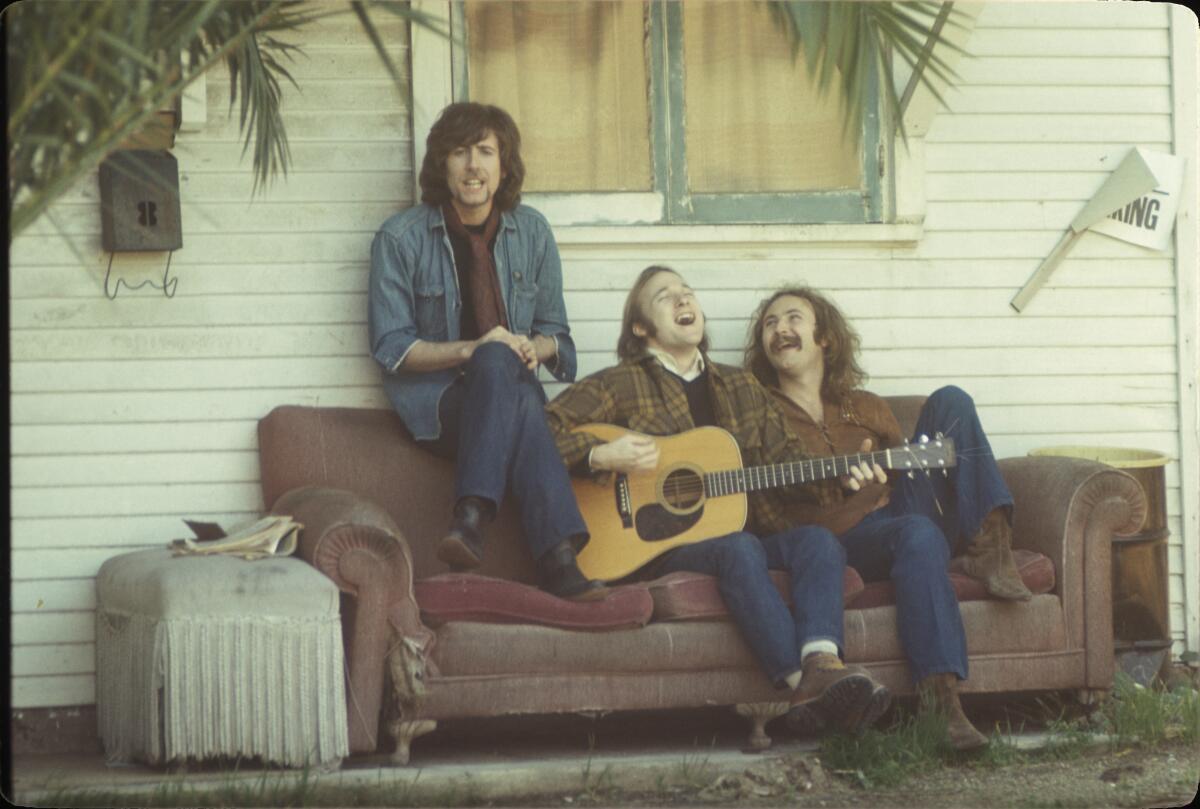
In “David Crosby: Remember My Name,” the musician said he had alienated most of the musicians with whom he had been close. Interviewed for the film, Roger McGuinn of the Byrds said Crosby “had become insufferable.”
Crosby was ousted from the Byrds in 1967. He had demeaned the abilities of his fellow musicians, drifted into onstage tangents about who really killed JFK, and sulked when the band refused to include “Triad” — his tribute to sexual threesomes — on an album.
Crosby’s CSNY bandmates had a far longer, but no less turbulent, history with him.
“There was an obvious dynamic between the four of us, and we’ve all done horrible things to one another,” Crosby told Vanity Fair magazine in 2019. “But I let them down worse than anything they ever did to me. I became a junkie. There isn’t any lower stage in human development than a junkie, and I did it right in front of them.”
Graham Nash and Stephen Stills were among those in the music world paying tribute to David Crosby after news of the singer’s death.
Born in Los Angeles on Aug. 14, 1941, David Van Cortlandt Crosby came from parents with old-money New York City roots in the Van Cortlandt and Van Rensselaer families. An early Van Cortlandt was the city’s first native-born mayor, from 1710 to 1719. Crosby’s paternal grandfather was treasurer of the Union Pacific railroad.
Breaking with family traditions, Crosby’s father, Floyd, and mother, Aliph, headed for Hollywood. Floyd, a cinematographer, received a 1931 Oscar for his work on “Tabu: A Story of the South Seas.” Aliph, a poet and a singer, stayed home to raise young David and his older brother, Ethan. She took the boys to symphony performances and organized family singalongs that profoundly influenced her younger son.
“Music kind of snuck up and kissed me on the ear,” he said.
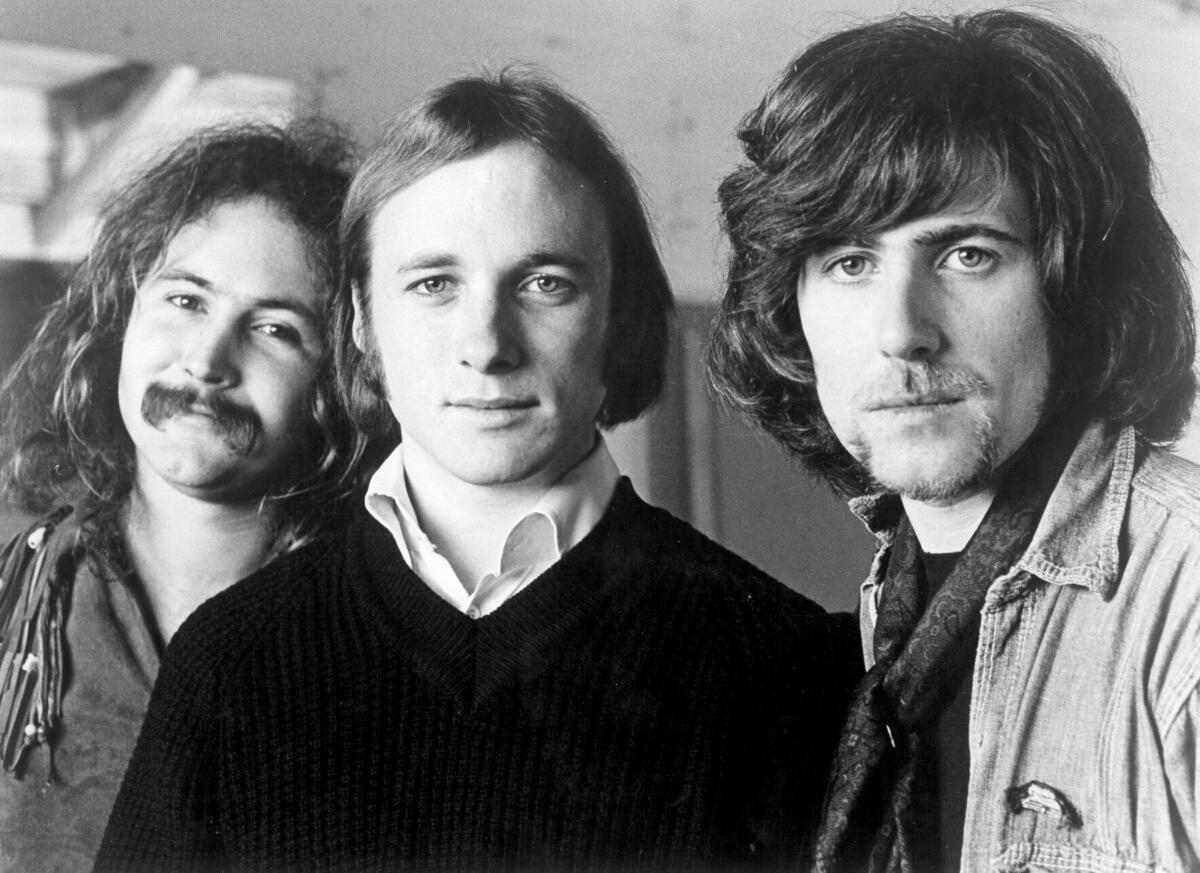
When he was 6, Crosby started singing harmonies as his dad played mandolin and the family sang from “The Fireside Book of Folk Songs.” At 14, he was given his first guitar — his brother’s old Silvertone acoustic.
“I’ve always said that I picked up the guitar as a shortcut to sex, and after my first joint I was sure that if everyone smoked dope there’d be an end to war,” he wrote. “I was right about the sex. I was wrong when it came to drugs. Who knew?”
David Crosby knows he’s going to die soon. He’s diabetic.
After his family moved to the Santa Barbara area, the teenage Crosby was in frequent trouble. At the exclusive Cate School in Carpinteria, he was thrown out for disabling the campus bell system. At Santa Barbara City College, he was suspended after his arrest for several house break-ins.
Playing folk songs at coffeehouses in Santa Barbara and then Los Angeles, he hurriedly left town after his girlfriend became pregnant. “I split,” he later recounted. “Hey, now’s the time for me to become Woody Guthrie.”
An itinerant rocker, Crosby played clubs and slept on couches across the country. In 1964, he returned to L.A., where he hooked up with a band that called itself the Jet Set, then the Beefeaters, and, finally, the Byrds.
The Byrds quickly became a phenomenal success. Their songs — with lush vocal harmonies supplied by Crosby, McGuinn and guitarist Gene Clark — broke into the Top 40 lists seven times. Their 1965 recording of Bob Dylan’s “Mr. Tambourine Man” sold nearly a million copies.
But Crosby’s abrasiveness cost him his job. One autumn evening in 1967, McGuinn and bassist Chris Hillman “came zooming up in their Porsches and said that I was impossible to work with and I wasn’t very good anyway and they’d do better without me. And frankly, I’ve been laughing ever since. … But it hurt like hell.”
Within four months, he had a new job. With other musicians and artists, he had gravitated to L.A.’s Laurel Canyon. He had an affair with Joni Mitchell, made a friend of Mama Cass Elliot and started playing with Stills, of Buffalo Springfield. Wowed when they saw British guitarist Nash perform with the Hollies at the Whisky a Go Go on the Sunset Strip, Crosby and Stills joined forces with him after the three jammed at a party.
In 1969, they released “Crosby, Stills and Nash,” an album that continued to sell in the millions for years to come. One of its most popular songs, “Suite: Judy Blue Eyes,” reflected “the chemistry between the three of us,” Crosby said.
The next year, with Young, they scored another huge success with the album “Deja Vu.” The album featured one of Crosby’s signature songs — “Almost Cut My Hair” — as well as Joni Mitchell’s “Woodstock.”
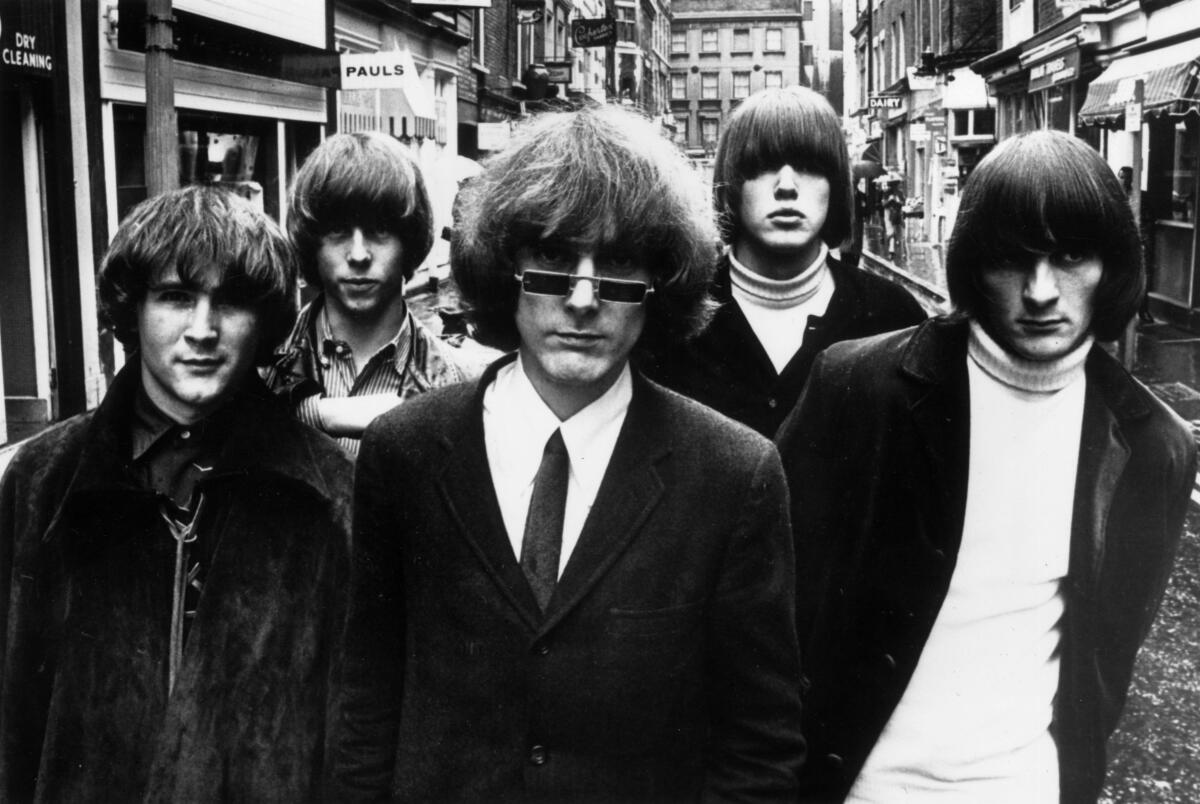
The group’s overnight renown and skyrocketing income — each man took home as much as $7 million in 1971 alone — helped cement rock as an industry, said David Browne, author of “Crosby, Stills, Nash & Young: The Wild, Definitive Saga of Rock’s Greatest Supergroup.”
“For all the imitators who came in their wake, no one ever sounded quite like them, and on a good night, the combination of their voices remained peerless,” he wrote. “And just when you were ready to count them out, they somehow managed to unleash a song or performance that gave new meaning to the phrase ‘keep hope alive’ well into the current century.”
But, while they were known for their exquisite harmonies, CSNY was regularly torn apart by internal clashes.
“There was a lot of competition,” said Guillermo Giachetti, a longtime crew member. “There are many ways to light a stage, and they would disagree about that. They would get angry and start fighting if a song ended in a black-out or a white-out or a spotlight. If one had sex with twins, the other guy had to have sex with twins.”
An ever-present cornucopia of drugs didn’t help.
“I chased perpetual pleasure and got a full measure of pain as a payback,” Crosby wrote. “And always there was dope — the best grass, pharmaceutical cocaine in factory-sealed brown glass bottles, and psychedelics cooked in the lab of Owsley Stanley, the Master Chef himself, the man whose very name was synonymous with quality LSD.”
David Crosby is ready to put his name on a line of weed — once federal prohibition is over.
By 1982, Crosby’s addiction was in full flower. He was freebasing — smoking — cocaine, because snorting it had burned holes in his nasal septum. For years, he had been shooting heroin, partly to obliterate the painful memories of his girlfriend Christine Hinton dying in a 1969 car crash. Makeup artists plastered over the sores on his face, but his eyes were glazed and his performances muted.
To make sure he didn’t overdose on tour, his bandmates hired Richard “Smokey” Wendell, a former Secret Service agent who had done the same job for John Belushi. The comic had died of an overdose just months earlier. “Great reference,” Crosby said sardonically when he was told about the arrangement.
While he was arrested a number of times on charges involving drugs, alcohol and guns, the most consequential bust came at a Dallas nightclub in 1982. Crosby was on a solo tour when police raided his dressing room to find him with a propane torch, a glass pipe containing drug residue, and a loaded .45 in his gym bag.
Over the next few years, he checked himself into half a dozen rehab programs and bolted from each. When his Dallas appeals finally ran out, he and his girlfriend, Jan Dance, fled to Florida, hoping to sail his boat to some safe Latin American haven. Finding the Mayan in disrepair — many of the fixtures had been sold off — he surrendered to the FBI and started serving his time in Texas.
“We’re not talking the drunk tank here,” he wrote in “Long Time Gone.” “We’re talking serious business: barbed wire, machine-gun towers and a 300-pound guy with no neck and a cowboy hat saying, ‘Hey rock star, git over here, boy.’”
After he was paroled in 1986, he recounted the horrors of prison to students at Beverly Hills High School.
“One of them asked, ‘Were you ever on stage stoned?’” he recalled. “The answer to that is that never once, until I got out of prison, did I ever record, perform, or do anything any way except stoned. I did it all stoned.”
By then, he was 45 and had been playing music his entire adult life.
While he made a point of healthier living after prison, Crosby was reportedly as little as a week away from death when he received his liver transplant in 1994. As he recuperated, his past caught up with him in an even more meaningful way.
He first met James Raymond over coffee in a UCLA hospital cafeteria. Crosby was at the hospital for a post-transplant checkup. Raymond was there, after a lengthy search, to meet his biological father — the musician who had abandoned his pregnant mother more than 30 years earlier.
Raymond, who had been put up for adoption at birth, told Crosby: “There are some things you need to know. I’ve never been hurt, never been hungry, nobody ever beat me up.”
Crosby was moved.
“I will be grateful to him until the day I die because he was so kind,” Crosby wrote. “He knew my heart, knew what I was thinking, knew what my fears were. He knew that I wanted him to love me, and that I loved him, and that I felt terrible for not being there and raising him.”
Raymond, it turned out, was a songwriter and keyboard player — “talented beyond belief,” in Crosby’s words, “and four times the musician I am.” Crosby, guitarist Jeff Pevar and Raymond formed the group CPR, touring together and making albums for eight years. Raymond also wrote songs and served as a producer on the albums Crosby made in a creative rush that started in 2014.
Crosby’s newer work was well received. Reviewing the 2018 album, “Here If You Listen,” rock critic Danny Eccleston said Crosby’s voice was “still elegant and ethereal.”
“While he can wag a finger as vigorously as the rest of his Boomer cohort, gentleness and twinkle have always sugared the Croz pill,” Eccleston wrote.
Long an advocate for legal marijuana, Crosby in his 70s planned to release Mighty Croz — his own, brand-name pot.
Crosby’s survivors include his wife, Jan, sons James Raymond and Django, and daughters Erika and Donovan. In addition, he fathered two children by artificial insemination for the singer Melissa Etheridge and her then-partner Julie Cypher.
For years, Crosby was asked whether he, Stills, Nash and Young, the most sporadic of the partners, would be reuniting for one last album, or one last tour.
The closest the old bandmates came was in 2015 when Crosby, Stills and Nash played at the White House Christmas tree lighting, and managed, to the clear horror of Barack and Michelle Obama, to mangle “Silent Night.”
Technical problems had doomed their performance, but the backstage combat afterward was intense.
“Nash heard someone gasp — and turned around to see Crosby and Stills lunging at each other,” Browne wrote. “A member of their management team jumped to attention and pulled the two apart. All the strains that had been simmering between them for decades … erupted like a geyser.”

For years, all four insisted the group was mortally wounded, if not dead. Now, Stills, Nash and Young refused to speak with Crosby, whose more recent sins had included publicly insulting Young’s wife, actress Daryl Hannah. He later apologized.
But asked in 2019 by “The Tonight Show’s” Jimmy Fallon whether the group might reunite, Crosby wouldn’t rule it out. The volatile, shoot-from-the-hip rebel acknowledged that the four of them “had bashed each other’s heads in so many times” but maybe this time would be different.
“There’s always a chance. Never say never, man,” he told Fallon. “I have no bad stuff in my heart about any of these guys. We made too much great music together. I love ‘em.”
On Twitter — where he was an extremely active user — he said his followers were constantly inquiring about why he couldn’t make up with the band.
“I probably get that 10 times a day on Twitter,” Crosby said in a 2019 interview with The Times’ Amy Kaufman. “‘Will you guys quit squabbling and do your gig? Because we need you now. You are our voice.’”
In his final years, the musician used the social media app to express his more controversial opinions — judging fan photos of homemade joints and even fellow performers.
Crosby released his final studio album, “For Free,” in July 2021. Produced by his son James Raymond, the album features guests Michael McDonald and Brian Wilson. The title track was a cover version of Joni Mitchell’s 1970 song from “Ladies of the Canyon.”
In one of his last tweets, sent Wednesday, Crosby joked that heaven was “overrated....cloudy.” But he had been reflecting on his impending mortality for the last few years.
“It’s hard. Who wants to die? I could use another entire lifetime,” he told The Times. “There’s so many things I still want to learn ... so much more music I’d like to make.”
Chawkins is a former Times staff writer.
More to Read
The biggest entertainment stories
Get our big stories about Hollywood, film, television, music, arts, culture and more right in your inbox as soon as they publish.
You may occasionally receive promotional content from the Los Angeles Times.
